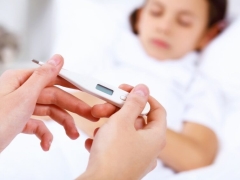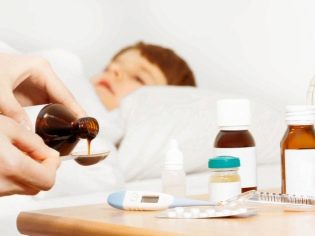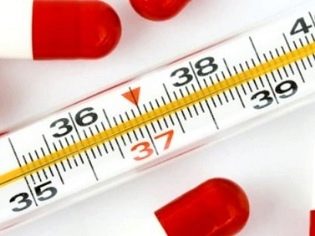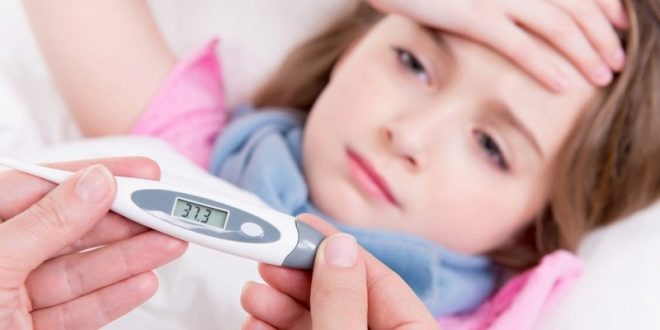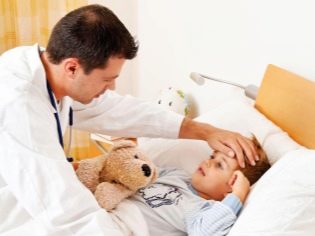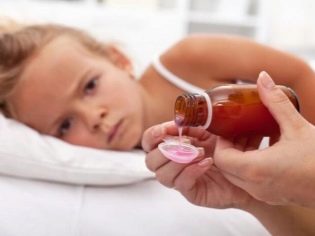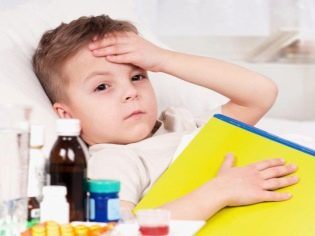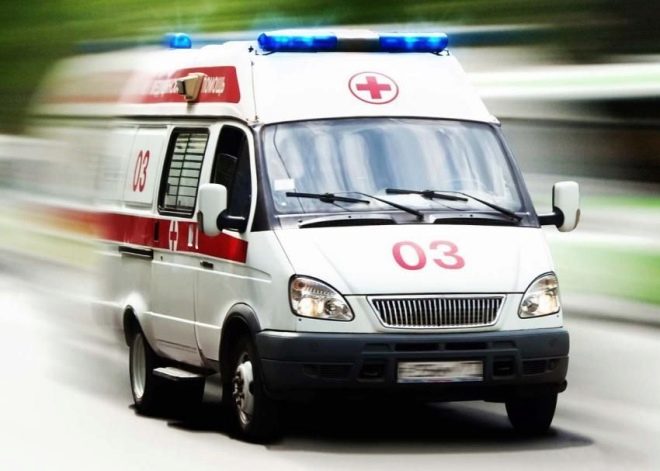How long does the baby usually have a temperature for the flu?
Influenza in a child is always accompanied by high fever. It can be said that fever is one of the inherent distinguishing signs of influenza infection. How much fever keeps and whether it is necessary to reduce it, we will tell in this article.
About the meaning of fever
To understand why the temperature rises in case of a flu disease, you need to know exactly how the virus works. It is easier to get infected with the flu, and even a vaccination made before the start of the epidemic season does not guarantee that infection will not occur - true, it increases the likelihood of an easier infection.
The virus enters the child through the upper respiratory tract. In the nose, nasopharynx, and larynx, the virus is inserted into the cells of the ciliated epithelium. These cells exist to provide protection against the entry of alien "guests", but at the same time the influenza virus suppresses local immunity and the cells quickly begin to break down. This causes the primary symptoms of the disease - a feeling of dryness, burning in the nose and throat, tickling, itching, dry frequent cough.
After the first line of resistance is defeated and the ciliated epithelium begins to exfoliate, the virus enters the bloodstream, and from this moment the high temperature rises. Initially, fever is the body's response to the penetration of the virus into the blood. The virus circulating in the blood disrupts the integrity of the blood vessels, causes a second wave of symptoms - muscle and joint pain, aches, headache, signs of intoxication.
The temperature of the flu in a child always rises sharply, unexpectedly, and almost immediately reaches the level of 38-40 degrees, but more often it is within 39.0 degrees. For the body high fever - one of the ways to protect against the virus, because when the body temperature rises, the virus becomes harder to survive in the changing conditions.
At the same time, with high heat, the production of natural interferons is stimulated, antiviral antibodies are produced more intensively. As soon as the immune system is ready to respond to the invasion, antibodies rush to the destruction of viral particles.
The stronger the virus, the higher the temperature is usually. That is why, of all acute respiratory viral infections (acute respiratory viral infections), it is the flu that causes one of the strongest fevers.
Duration of the febrile period
To understand how long the period of fever lasts, one must take into account the child’s age, the general state of his health, as well as the severity of the flu infection. Immature immunity due to age is weaker in very young children, and therefore, as in children with chronic diseases or reduced immunity, their temperature usually lasts 4 to 7 days. The older the child, the shorter the fever will be.
The duration of high temperature in older preschoolers, schoolchildren and teenagers is usually 3-5 days. In the mild form of flu, fever rarely lasts more than 5 days; medium and severe forms of flu are characterized by a longer duration of fever. In babies up to 3 years old, on average it lasts 4-6 days.
In the absence of complications, the temperature decreases as soon as the antibodies manage to defeat the virus, however, for several days after this, the baby will feel strong weakness, because the body still needs to get rid of the defeated virus particles. It is because of weakness and a sharp decline in immunity after a victory over the virus, sometimes children have a low body temperature after the flu (at the level of 35.5-36.0 degrees). Thermoregulation after influenza only gradually returns to the original data.
What to do if the fever lasts longer?
If the temperature lasts longer than the above intervals, this may indicate the development of complications. Symptoms may appear differently. If, after 5 days from the onset of the disease, the temperature stays around 37.0 degrees and does not stray, and the child’s state of health remains deplorable, it is likely that a secondary infection with a bacterial infection has occurred due to the weakening of the child’s immune system.
Also, the child may feel better in 5-6 days, the temperature returns to normal, but after a few days the temperature rises again, although not to such high values as the first time - mostly to subfebrile values (37.0-37, 9 degrees). Such a scenario is a clear indication of developing complications.
Both in the first and in the second case, it is necessary to show the child to the doctor, pass tests, undergo additional examinations, evaluate other symptoms and begin treatment of a specific complication according to the scheme recommended by the attending doctor.
Do I need to reduce the temperature?
The first impulse of any parents when the thermometer shows high heat is to bring it down at any cost. However, you should not hurry, because, as we have already found out, heat is a protective mechanism. If the temperature gets off medication constantly, the body crumbs become defenseless. In addition, the period of the disease may significantly extend, and the risk of complications increases.
Therefore, there is a certain standard of care for children at high temperatures. In order not to disturb the immune processes and the production of interferon, it is not customary to bring down the temperature to 38.0 degrees. If the values on the thermometer exceed these values, you need to carefully consider the age and well-being of the child.
A teenager can suffer up to 39.0 degrees without pills and syrups. A child from 3 to 7 years old should get a febrifuge at 38.5 degrees. Very young children need to reduce the heat of 38.0 degrees. If the child’s condition is severe, he needs antipyretic drugs for any values above 38.0 degrees, regardless of age.
It is necessary to treat the child in a complex way, and means of temperature in this complex of measures are not the most important thing. The heat itself represents a certain danger, and that is why it must be carefully monitored.
How to reduce the fever of a child
Algorithm of actions of reasonable parents - waiting tactics. If the symptoms of the flu have manifested themselves in all their glory, you should definitely put the child in bed, temporarily transferring even an inveterate fidget to strict bed rest. If the child does not spend energy on movement and play, recovery will be faster.
After the baby is stripped down to panties and T-shirts and covered not with a warm quilt, but with a light sheet, you can call the doctor and start providing first aid. First you need to ventilate the room, make sure that the air temperature in it is not higher than 21 degrees, and the humidity is at least 50-70%. Such conditions will help maintain the mucous membranes of the respiratory tract in a "combat-ready" state.
It is important to provide the child with plenty of warm drink - it will help prevent dehydration. Most often at high temperatures, the youngest children suffer critical fluid loss. The child should be given to drink liquid at room temperature - compote, juice, tea, chamomile decoction.It is forbidden to drink baby milk, juice, lemonade, carbonated mineral water. If the baby does not voluntarily drink, try using a disposable syringe without a needle, by typing into it a drink and directing the jet along the inner surface of the cheek.
If the temperature exceeds 38.0 degrees, give the child a febrifuge at the age dose. Do not give drugs based on acetylsalicylic acid, since it is prohibited for children under 16 years of age and may cause the development of lethal Ray's syndrome. The best choice - drugs based on paracetamol. Adolescents can be given pills, preschoolers - syrup, and infants - rectally enter the suppository with paracetamol.
If the heat does not stray or continues to increase, you should call an ambulance. Perhaps the child will need intramuscular injection of drugs that quickly reduce the temperature. The so-called lytic injection will make any team of "ambulance". It consists in equal shares of suprastin, analgin and papaverine.
It is necessary to control the temperature level and make measurements for the child every 2-3 hours. As you recover, the need for measurements will disappear.
When can you not do without medical help?
Attempts to cope with the temperature are independently excluded if a child is ill up to one year old. Doctors try to hospitalize and treat such babies under the supervision of specialists, since at this age the manifestations of various severe complications of influenza infection are most likely.
If the flu occurs in severe or toxic form, with vomiting, loss of consciousness, convulsive syndrome, medical help is necessary. You should not rely on your knowledge and skills, because the complications of the flu are diverse and very dangerous, especially for children under 3 years old, among whom is the highest percentage of deaths from influenza infection.
For information on how to treat the flu, see the next transfer of Dr. Komarovsky.
